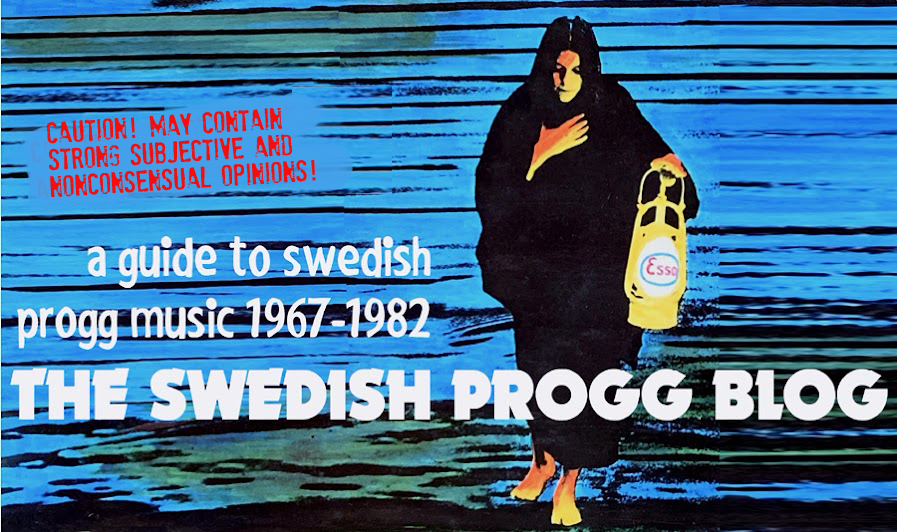Björn J:son Lindh's name pops
up everywhere on this blog. No wonder – he was part of the core
staff of studio musicians, and remained so for decades, often performing with guitarist Janne Schaffer. His 'Credits'
section at Discogs has almost 600 entries, and there are probably more
albums featuring J:son Lindh still not listed. He was well-versed in
multiple genres, wrote music for movies and television, and more
important his breathy and sometimes even aggressive flute style was
distinct and original. He remained active up until his death a few
days before Christmas in 2013. Still many Swedish casual listeners
have a limited view of J:son Lindh's scope, largely based on the
romantic and new age tinged 1980 hit ”Brusa högre lilla å”.
While true a lot of his albums beyond the 1970's are best avoided,
some of his earliest solo works are pretty great.
Some of his albums were released internationally under the moniker Jayson Lindh.
Ramadan (Metronome, 1971)
Instrumental
International relevance: ***
First solo outing from Björn J:son
Lindh features the likes of Kenny Håkansson, Jojje Wadenius, Jan
Brandel and jazz men Bobo Stenson and Palle Danielsson. ”Ramadan”
touches on funk, renaissance music, Swedish folk, Eastern scales,
jazz and multiple points in-between. The exuberant ”Love March”
was culled from the album and the single quickly became a radio
favourite. The warm sounding production, typical to Metronome albums
of the 70's, ensures a rewarding listen even today.
Från storstad till grodspad (SR, 1971)
Instrumental, Swedish vocals
International relevance: ***
A very different, interesting but nevertheless largely
parenthetical release in J:son Lindh's early ouvre, recorded with a
symphony orchestra and released through Swedish Radio's imprint. The
experimental and collage-like ”Från storstad till grodspad” has
its admirers and the first side – devoted in full to the suite
”Musik från en storstad” – may interest fans of early Mothers
of Invention. Side two is all over the place, with prog (”Grytnäs
sväller”), jazz and modernist art music. Hawkey Franzén appears
on ”I grodspadet”. It's a diverse album, or more precisely way too inconsistent.
Cous Cous (Metronome, 1972)
Instrumental, wordless vocals
International relevance: ***
International relevance: ***
The proper second album isn't quite as
cohesive as ”Ramadan” but it's still a must if you like the J:son
Lindh's debut. Highlights includes ”El Henna” in vivid Oriental
colours, and the minute track ”Abdo” which sounds a bit like the
long tracks off US Kaleidoscope's magnificent albums. Both tracks
feature Egyptian lute player Abd al-Rahman al-Khatib (who also lends
his rich baryton hum to ”Abdo”). There are other great moments
here, but these two tracks alone would still make ”Cous Cous” a
mandatory listen.
Sissel (Metronome, 1973)
Instrumental
Instrumental
International relevance: ***
His third Metronome album moves in the
territory staked out by ”Ramadan” and ”Cous Cous” but hasn't
quite the same amount of emanating mystique. Still an album to own
for the funky groove of ”Your Own House” and the fast moving
title track which is a most meritorious example of what later would
develop into fullblown fusion. Along with ”Ramadan” and ”Cous
Cous”, ”Sissel” makes up an informal trilogy that together
stands as Björn J:son Lindh's finest hour.
Boogie Woogie (Metronome, 1974)
Instrumental
International relevance: ***
Things definitely began to slide with
”Boogie Woogie”. With it J:son Lindh took a further step towards
the fusion amalgam, adopting a studio sound that pretty much killed
the graceful mysticism of his previous albums. Only closing track
”Pivo” retains the Oriental influences to good effect, making it
the self-evident high mark of ”Boogie Woogie”. Released as
”Second Carneval” in the US.
Raggie (Metronome, 1976)
Instrumental
International relevance: ***
Take a look at the cover and you've
heard the album. The pink fuzz and soft focus of the sleeve is also prevalent on
the album itself and turns the music into an unengaging smear –
smooth perfection over musical content. The sole exception is
”Anniversary March” with Mats Glenngård's fiddle adding a much
needed spirit. The softer tracks try to capture the low-key sense of
wonder familiar from the 'trilogy', but they end up as hopeless
slippery new age drivel.
Bike Voyage II (Sonet, 1978)
Instrumental
International relevance: ***
After signing with Sonet, J:son Lindh
appeared with this album which is marginally better than ”Raggie”,
largely thanks to a couple of tracks with a pronounced Oriental feel
like the traditional ”Billathi Askara”, enhanced by Egyptian Nāgi
al-Ḥabaši fervent cello playing, and ”Ah Q” with a guest
appearance from Okay Temiz on tablas. But it's ”A Day at the
Surface”, ”Hotel and Drumsticks”, ”Colwyn Way”, and
”Boathouse Club” (the latter with an absolutely horrendous synth
part) that define the album as just another bloodless fusion album, as stone dead as the granite bust on the cover.
Released as ”A Day at the Surface” in the UK.
Ramadan full album playlist
Från grodspad till storstad full album playlist
Cous Cous full album playlist
Sissel full album playlist
Raggie full album playlist
Bike Voyage II full album playlist








Where can you get these? Are they available on CD?
ReplyDelete"Cous Cous" and "Boogie Woogie" were briefly available on CD, but I don't think any of the others were. Which is strange!
ReplyDelete